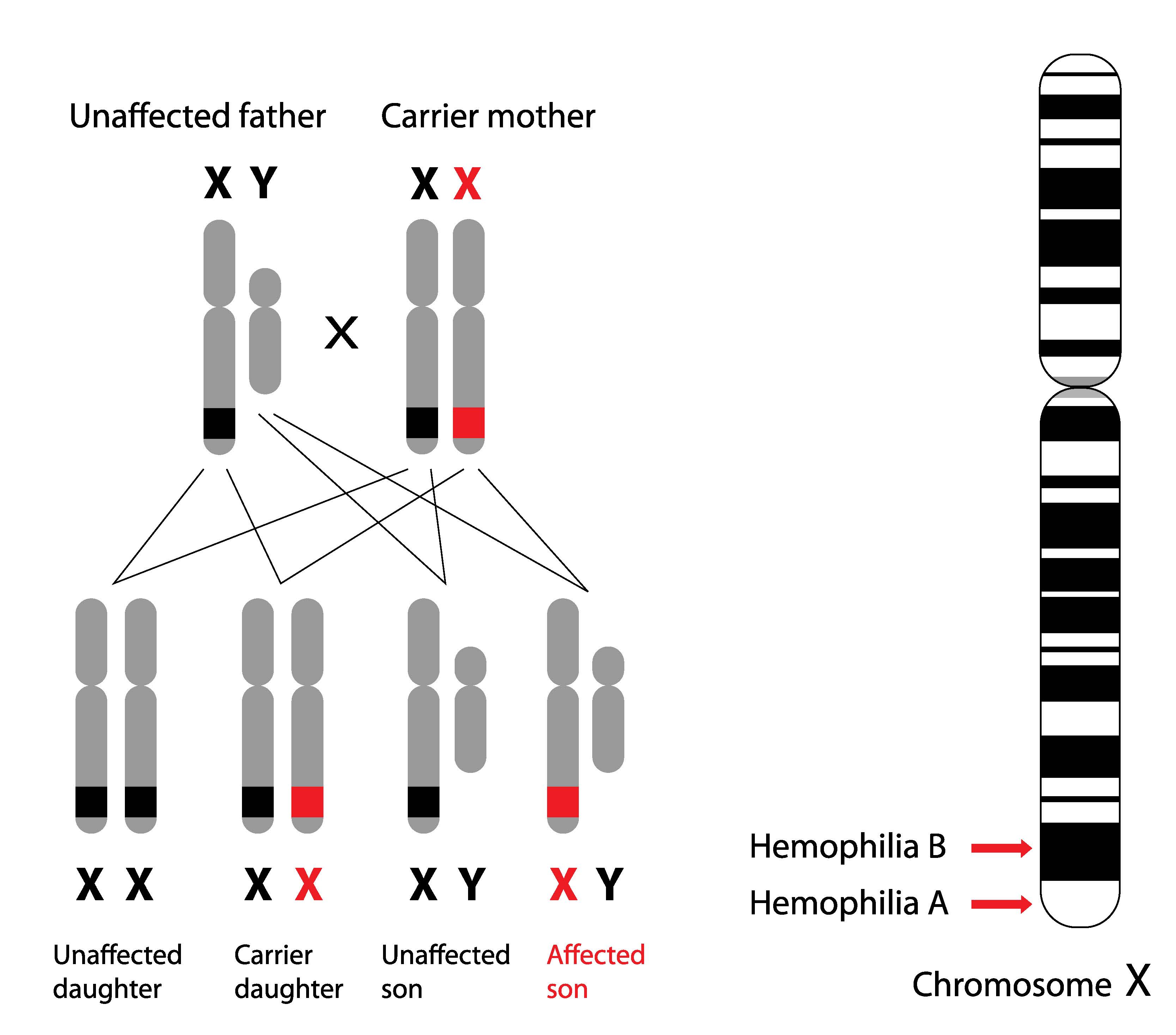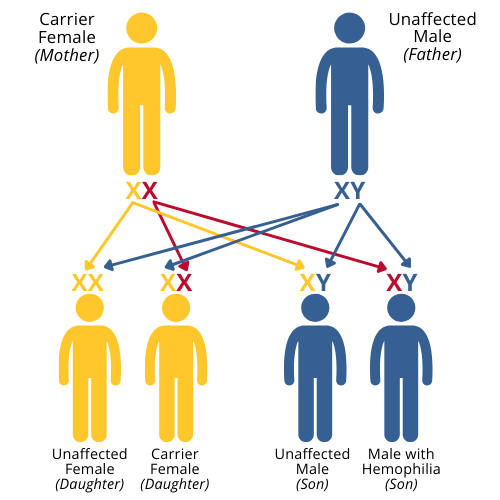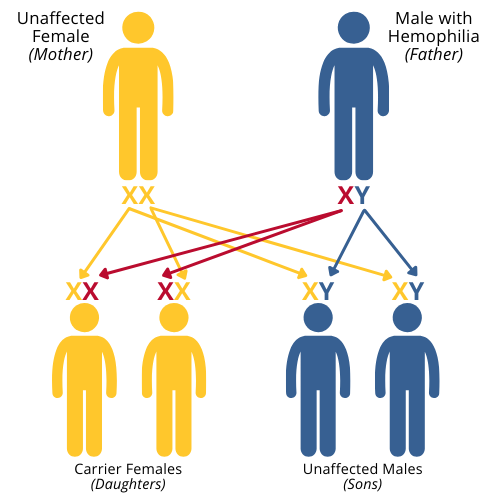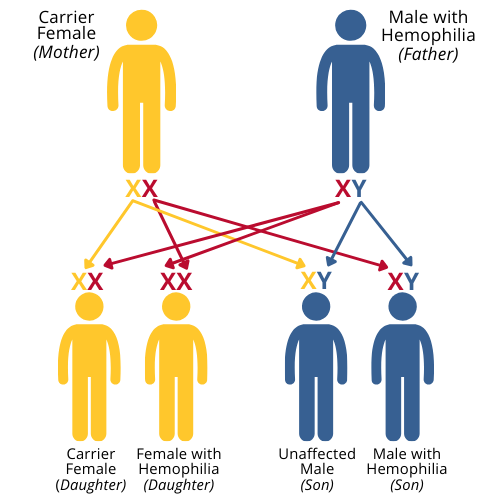Genetics
Both Hemophilia A (factor VIII deficiency) and Hemophilia B (factor IX deficiency) are congenitally inherited conditions. Both genes for Hemophilia A and Hemophilia B are located on the X chromosome.
When a variant is present in either of these genes, it can alter how that gene functions, resulting in Hemophilia.
Pathogenic and likely pathogenic variants in the factor VII gene will result in Hemophilia A and pathogenic and likely pathogenic variants in factor IX will result in Hemophilia B.
Both Hemophilia A and Hemophilia B are inherited in an X-linked fashion.  This means that the gene is located on the X chromosome. As discussed above, these conditions are typically considered to impact only biological males as they have a single X chromosome and a single Y chromosome whereas biological females have two “X” chromosomes. However, we now recognize that biological females who are carriers for a sex-linked condition may be symptomatic themselves.
This means that the gene is located on the X chromosome. As discussed above, these conditions are typically considered to impact only biological males as they have a single X chromosome and a single Y chromosome whereas biological females have two “X” chromosomes. However, we now recognize that biological females who are carriers for a sex-linked condition may be symptomatic themselves.
In some families, there is no known family history of Hemophilia. The condition appears to occur out of nowhere, leaving the family confused or even shocked. This can happen for several reasons. First, the family may not have known about or may have forgotten about ancestors who had bleeding conditions. In many parts of the world, where care is limited, affected individuals may not have been able to access the care they needed and passed at an early age and, perhaps, without a diagnosis. Second, the family’s specific variant may have been passed down by biological female carriers without anyone knowing. Generations could pass without a biological carrier female having an affected child or a carrier child. Thirdly, and as mentioned previously, new spontaneous variants can occur during the formation of gametes (eggs and sperm). Ultimately, once the variant is present within the family, it has the chance to be passed on to future generations. Although science continues to advance, we do not currently have methods to “rewrite” the pathogenic variant or replace it with a correctly coded gene.
Individuals who carry a single copy of a variant for either condition are typically referred to as “carriers.” In X-linked conditions, we typically consider these individuals (biological females) to be unaffected and not express symptoms of the condition because they have another “X” chromosome with the gene that is properly coded to compensate for the gene with the pathogenic variant. As time and our understanding have increased, we acknowledge that biological female carriers may have symptoms, different symptoms, or may be fully affected themselves. This appears to be a possibility in Hemophilia as well.
Biological female carriers for Hemophilia may have low factor levels (<50%) and are thus at risk for prolonged bleeding such as heavy menstrual bleeding, prolonged bleeding from trivial cuts, or easy bruising, to name a few.
NOTE: Hemophilia A and Hemophilia B result from changes to the factor VIII and factor IX genes that are located on the X chromosome and are inherited in an X-linked fashion. Hemophilia is congenital. While most individuals affected with these conditions are biological males, some biological females can be symptomatic as well. Most individuals have affected family members, but some may be the first within their family to have the condition as a result of a new event in the egg or sperm at the time of conception.
Genetic Scenarios
The following scenarios provide examples to illustrate how genes can be passed on and what the chances would be to have affected offspring if one or both parents are affected, a carrier or unaffected. As we consider these scenarios, it is important to remember that we cannot control the genes contained in our eggs and sperm.
Which chromosome and gene a mature egg or sperm receives is a random event. Also, it is important to remember when looking at these illustrations that the possible outcomes represent the chances for a single event. Meaning, as you look at these scenarios, it may make sense to this, “If I have four children, only one should be affected. If I already have an affected child, then I am not at risk to have another affected child”. We see this misunderstanding often. Instead, each illustration represents all possible outcomes in each pregnancy. In other words, if you are asked to flip a coin, and the first attempt lands on “heads”, that does not guarantee the next time that you flip that coin it will land on “tails”. The chance of landing on “heads” or “tails” resets with each flip. The same is true with conception or pregnancy. With each conception, in each scenario, the various scenarios reset.
1. Biological female is a carrier for Hemophilia and conceives a child with an unaffected biological male:

• 50% chance that a biological female (daughter) will be a carrier and may/may not be symptomatic themselves
• 50% chance that a biological male (son) will be affected with Hemophilia
• 50% chance that a biological female (daughter) will not be a carrier and will not be symptomatic
• 50% chance that a biological male (son) will not be affected
NOTE: Within medical literature (and even amongst genetic professionals) it is stated that there is a 25% chance of having an affected child. This can be confusing to parents/individuals when they hear this because when someone says, “there is a 25% chance”, they are considering both biological sexes (male and female). In other words, when a carrier mother conceives a child with an unaffected father, there are four possibilities. Only one of those four possibilities will result in an affected child.
2. A biological male is affected with hemophilia and conceives a child with an unaffected and non-carrier biological female:

• All biological females (daughters) will be carriers for hemophilia and may/may not be symptomatic themselves
• All biological males (sons) will be unaffected because they received their “X” chromosome from their mothers who are unaffected and not carriers.
3. A biological male is affected with hemophilia and conceives a child with a biological female carrier:

• 25% chance that a biological female (daughter) would be a carrier for hemophilia and may/may not be symptomatic themselves
• 25% chance that a biological female (daughter) will be affected with hemophilia (she will have received both X chromosomes from each parent that has the pathogenic variant from the factor VIII or factor IX gene)
• 25% chance that a biological male (son) will have hemophilia
• 25% chance that a biological male (son) will be unaffected
